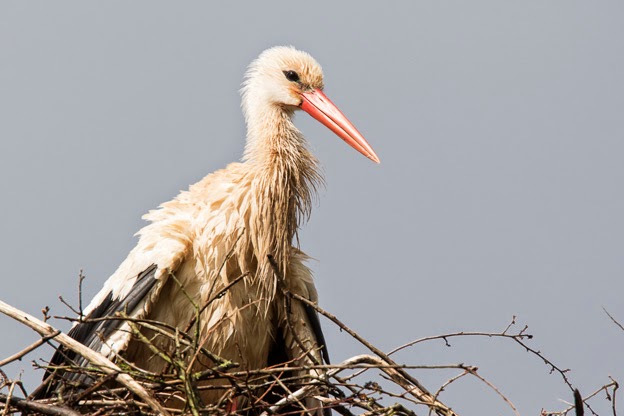The thing that amazes me today is that we have to cross the channel to see them. They are very occasional visitors to the UK, even though they are present in strength just across the water. Why they have not established themselves here is a mystery to me. I am tempted to offer to eat my hat if they have not started breeding here in the next five years. Just as a precaution I am putting a nice soft felt hat to marinate in olive oil, lemon juice and garlic with a view to making a slow-cook stew in 2020.
According to Birds Britannica, there are only two recorded nesting attempts by this species. One in Edinburgh in 1416, and the other in West Yorkshire in 2004 - and that's it.
This makes them a very unusual treat for the British bird enthusiast and, to be honest, I was not even expecting to see them on my very recent birding trip to Normandy - I thought that they would be further south. I did however, see seven on my first day just by following a vague tip that they were nesting in a certain area near the mouth of the River Orne. It was just a matter of luck that they came drifting over the spot where I had stationed myself.
A few days later though I was given some specific intelligence, backed up by a map. So I made my way to the ruined Chateau de la Riviere near Carentan, and they there were perched on the crumbling walls busy building their nests.
I drew up on the road alongside. I was the only one there so, fearful of scattering them, I descended from the car with the utmost caution. I walked slowly, stalked you might say, to a vantage point along the road. Then a car containing a French family arrived at high speed. Parents and children tumbled out and started shouting and pointing and running up to find gaps in the hedge, just as if they were at the zoo. The Storks did not mind.
The Chateau is interesting in itself, I looked it up on the French Wikipedia. There was a picture, complete with Storks, and a few paragraphs of history. I cut and pasted these into Google Translate to see the English version. Apparently it was largely destroyed during the Normandy invasion in June 1944. The Germans had been using it to store munitions. Then Google Translate did what it does best, it came up with something to make you choke with laughter. After a brief history, with dates, it stated "it is now used as a storage place for Storks"
The size of the nest seemed to have something to do with the size of the base available, the one above is small. I know that it is common practice on the Continent to fix large circular platforms, such as old cart wheels, to high places to attract the birds. Presumably these lead to nests much more like the one below.
I watched as the Storks flew in with twigs for the nest.
Whilst others carried softer lining material which seemed to be mud, moss or grass.
Whilst yet others chucked it out again! Presumably he brought the wrong stuff.
When a bird returned to the nest, it usually set off a sort of greetings ritual. Both birds threw back their heads and made loud "clacking" sounds in rapid succession. The production of the sound seemed to involve an inflated throat pouch.
So, to finish this Blog, here are just a few more of the many photos I was lucky enough to get on this exciting visit.
Please do visit my webpage www.johncrabb.co.uk and "Like" my Facebook page at www.facebook.com/JohnCrabbWildlifeImages
Also, please tell your friends about this Blog - thanks!
The next blog will show some of the other pics I managed to take in Normandy.



















No comments:
Post a Comment